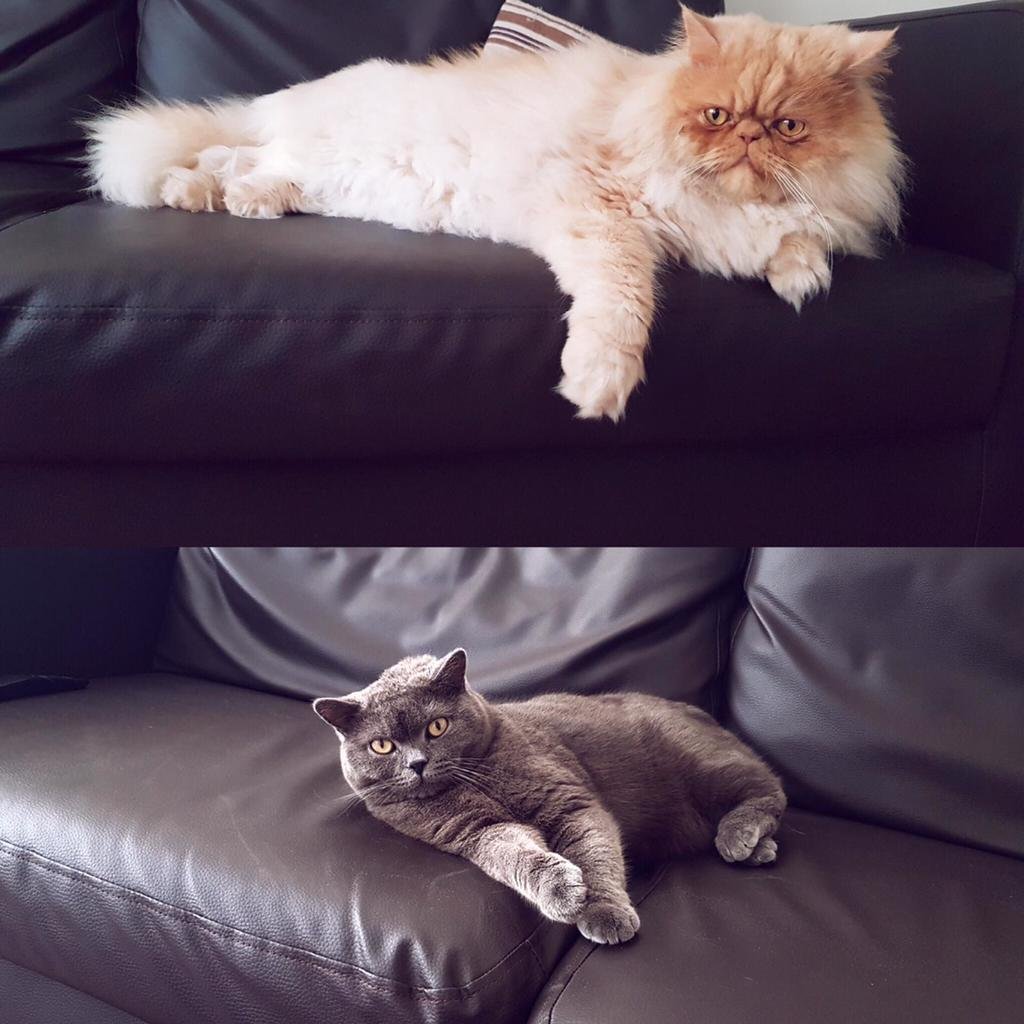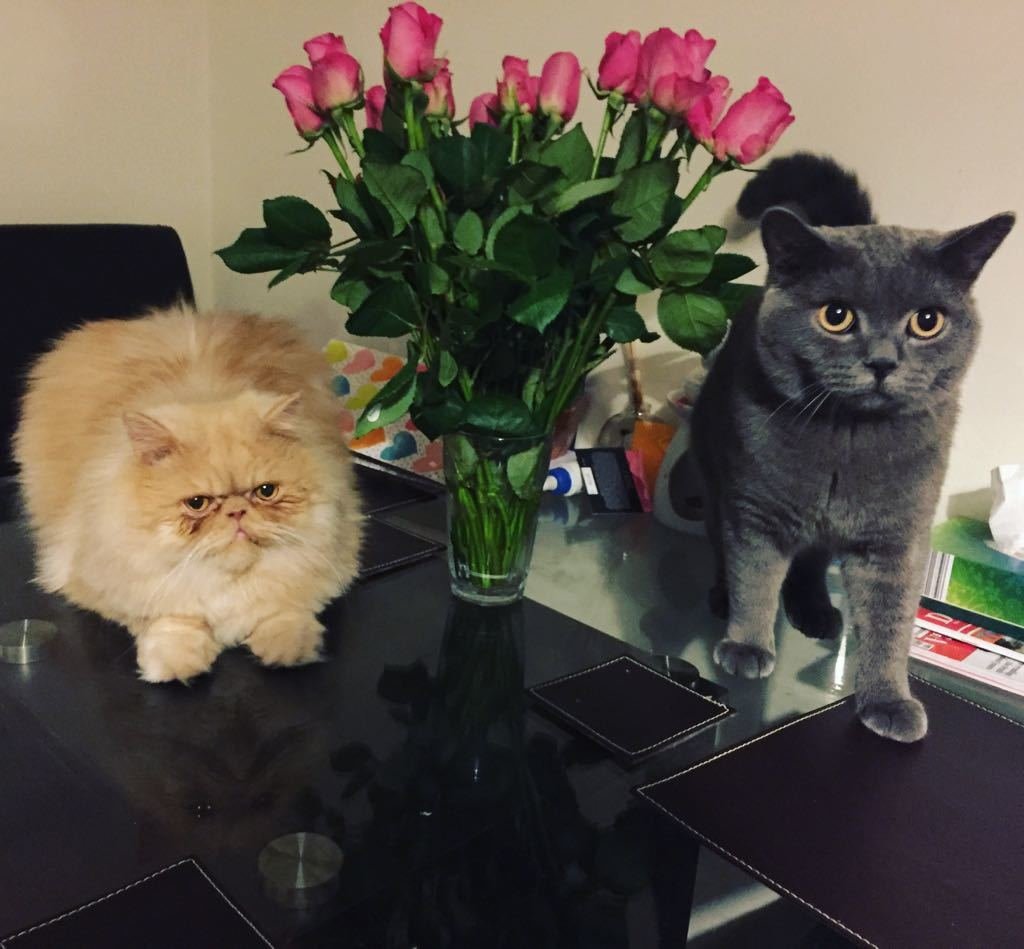
Persian cats and British Shorthairs are very different cats, or are they?
Well, I’m in the fortunate position of owning both so I’m in a good place to compare the two breeds. I always try and refrain from breed stereotypes as these can often be debunked and, in general, it’s hard to find a cat that meets all the typical breed stereotypes.
In short how different are Persian cats and British Shorthairs? Well, they’re certainly different in some respects but not as much as you would think. After all, cats are cats, right?
I’m going to take a closer look into the British Shorthair in this post and then compare my experiences of owning both breeds.
What is a British Shorthair?
The British shorthair originates from Britain (you might have guessed) it’s a pedigree version of the traditional British domestic cat.
Apparently, the British Shorthair’s origins date back to the first century AD, making it one of the oldest cat breeds in the world.
The British Shorthair is available in a range of different colours but it’s known for its “British blue” appearance and most recognisable in this colour. The British blue is a blue-grey colour and typically has copper coloured eyes. My own British shorthair Teddy is in this colour as you can see from the picture below.

The British Shorthair is a stocky, powerful, cat with short thick legs and a chunky body. Males can weigh as much as 17.63 lb (8 kg) but generally weigh somewhere between 9–17 lb (4.1–7.7 kg) and females generally weigh 7–12 lb (3.2–5.4 kg). My male British shorthair weighed just under 5 kg (11.02 lb) the last time he was weighed at the vets. He’s only 2 and half years old as I write this post so he may grow a bit more as British Shorthairs tend to be slow to mature and generally don’t finishing growing until they are 3 years old.
British Shorthair life expectancy
The British Shorthair is classed as a long-living cat and they tend to live between 14-20 years of age.
How does the British Shorthair differ from the Persian cat?

Appearance-wise these two cats are worlds apart, the Persian cat is a long-haired cat that needs grooming often and the British Shorthair is a shorthaired cat that has a thick, dense coat that does require grooming still but not on the same level as a Persian.
Their body shape is different as well, in terms of bone structure. This becomes more noticeable when you’ve bathed them and you can see under the huge mass of fur that the Persian has. The Persian looks slightly lanky under the fur with a more slender body. The British Shorthair is more compact.
Before buying my British Shorthair I had heard that they didn’t like being lifted off the floor and this is certainly true with my British Shorthair Teddy, he doesn’t like been lifted up. The British Shorthair isn’t the best climber or jumper either, Milo my Persian cat is a far better climber and jumper than teddy.
How does the British Shorthairs personality differ from a Persian Cats?
In my experience they differ quite a bit, my Persian cat doesn’t meet any of the typical Persian stereotypes, he’s very un-Persian like in that respect. So this may have some bearing on the below comparison that I make.
The British Shorthair is more calm, gentle and laidback than the Persian. The British Shorthair is also noticeably lazier than the Persian. Although in terms of activity levels I would say they’re very similar.
In my experience neither are what I’d describe as lap cats.
The Persian isn’t the most vocal of cats generally but I find that the Persian is slightly more vocal than the British Shorthair. Overall, personality-wise they are quite different.
British Shorthair health issues
The British shorthair doesn’t suffer from many breed specific health issues and it’s generally considered a healthy breed.
However, there are a few health issues some British Shorthairs can suffer from these include;
• Hypertrophic cardiomyopathy (HCM)
• Polycystic kidney disease (PKD)
• Hemophilia B
Persian Cat or British Shorthair?

Ultimately the choice will come down to personal preference, if you want a low maintenance shorthaired cat then the British Shorthair or the Exotic Shorthair are great choices, the latter is similar to the Persian without the grooming issues.
I personally think both cats are best kept as indoor cats but if you were looking for a cat that can venture outdoors then I think the British Shorthair is better suited due to its shorter fur. I’ve seen a few Persian cats that were outdoor cats and their fur was badly matted.
Persians are very unique and beautiful looking cats, especially when well groomed. From the way they prance around to their glowing coats, this is a breed with a lot of character that makes a great pet in any family home.
Which is best for you?
I think the easiest way to decide is down to you and your personal circumstances, if you’re short on time and lead a hectic lifestyle then the Persian may not be the best choice. This breed requires a huge amount of grooming to keep their fur in pristine condition (don’t underestimate how much work is required). You will need to brush your Persian each day and bath them every 2-3 weeks.
It’s not just their fur that needs maintaining Persians are prone to eye drainage and they need their eyes wiping each day. All of this is fine if you have time on your hands, if you work a busy city job and spend long periods of time away from home then, in my opinion, a Persian isn’t ideal. That’s not to say you shouldn’t get one but you should be aware of how much work is involved.
If you want a cat that’s easy to maintain and only needs brushing once per week then the British Shorthair is ideal. And if you’re like me and want all of the above then get both breeds and enjoy the pleasure these two great breeds provide!
Do you have a British Shorthair or a Persian cat or both? Let me know in the comments section below.
Idk if my kitten is a British long hair or person , because her mother is a British short hair and father is Persian . So basically her resemblance be as British short hair colour and the fur is fluffy as persian cats . So Iam kinda confused what do I call her.